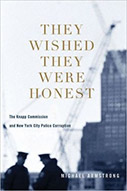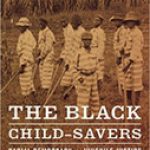They Wished They Were Honest: The Knapp Commission
and New York City Police Corruption
 Author: Michael F. Armstrong
Author: Michael F. Armstrong
Publisher: New York: Columbia University Press, 2012. 272p.
Reviewer: George L. Kelling | July 2013
The title, They Wished They Were Honest, paraphrases Frank Serpico who, along with David Durk, blew the lid off systemic corruption in the New York City Police Department (NYPD) in the 1970s. The full paraphrase of Serpico’s account was that 10% of New York cops were seriously corrupt; 10% were scrupulously honest; and the rest “wished they were honest.” Serpico, made famous by the movie starring Al Pacino, was a patrol officer; Durk, less famous but perhaps even a more central player than Serpico, was a detective. These two, frustrated by the NYPD’s command staff’s refusal to pursue their accounts of corruption, finally went to New York Times reporter David Burnham. In April 1970, the Times published his front page story alleging that not only was corruption rife in the NYPD, it was ignored by both the NYPD’s leadership and Mayor John Lindsay. Lindsay’s response was to create what is known as the Knapp Commission, named after its chairman, Whitman Knapp, with Armstrong as its chief investigator. And, after the resignation of Commissioner Howard Leary, Lindsay appointed Patrick V. Murphy as Police Commissioner. Murphy, originally from the NYPD and formerly the chief of the Syracuse, Washington D.C., and Detroit Police Departments, was widely known even then as one of the leaders of American policing. They Wished They Were Honest is an insider’s account of the Knapp Commission’s activities and its relationship both to the Mayor and the Police Commissioner.
It should be noted up front that I was familiar with many of the players in New York City during those days. I worked for Murphy and his close colleague, William Smith, for seven years after they left the NYPD and took over the Police Foundation. (Although for the first five and a half years when I was doing field work my contacts were channeled through “Joe” Lewis – the Director of Evaluation and my last mentor.) I knew and worked many years with “Ed” Kiernan, President of the Patrolman’s Benevolent Association (PBA), especially after he became President of the International Association of Police Unions, AFL-CIO. I had met other key players: Michael Codd, “Neal” Behan, “Sid” Cooper, and others. I remember all. Even those I didn’t know very well often left strong impressions on me, especially Behan and Cooper.
Basically They Wished tells two stories: the first about the internal operations of the Knapp Commission, the second about the relationship between the Knapp Commission and the NYPD, especially after Patrick V. Murphy became police commissioner. The first story is an interesting portrayal of an ephemeral organization that publicly appeared to be high powered and well endowed, but which in fact had little political support, at times was on shaky legal grounds, and lurched from one financial crisis to the next. By the time of the shocking public hearings in October of 1971, the Commission and staff were more “whistles and smoke” than a substantial organization. That Armstrong and a few commissioners, prestigious though they were, managed to have the influence they ultimately did, was a remarkable achievement. To this day, the operations of the Knapp Commission are key in the vernacular of police corruption control
The second story concerns the relationship between the Commission and the NYPD. What becomes clear at the outset was that there was no love between Knapp Commission staff and commissioners and NYPD leadership. For Armstrong, Murphy was paranoid about the Commission: after his appointment as Police Commissioner, “He [Murphy] wanted the Commission ended – right away” (p. 23); during inquiries about a hotel meal signed off on by Chief of Detectives Seedman late in the Commission’s work Armstrong writes, “Knowing Pat Murphy’s defensiveness – if not paranoia – where we were concerned . . .” (p. 173); and “[O]ur revelation to Murphy triggered a firestorm . . . all premised on the fear that the Commission might have something nefarious in mind, like blindsiding Murphy during the hearings . . .” (p. 173).
Murphy’s view of Armstrong and Knapp was no less complimentary. In his 1977 book, Commissioner, Murphy writes condescendingly about regular breakfast meetings he had at the Yale Club with the two: “Armstrong and Knapp talking about police corruption were like young boys under a Christmas tree stealing a peek before Mommy and Daddy got up.” Murphy goes on: “This was understandable. They were newcomers. The world of cops and robbers was exciting to them. Courses in shakedowns and narcotic pads weren’t listed as electives in the Yale college catalogue. . . It was so terribly exciting . . . I put up with these meetings . . . “
Mayor Lindsay was part of the problem. He created a Commission, appointed powerful commissioners who, in turn, convinced a talented Harvard and Yale educated lawyer who headed the Securities Fraud Unit in the U.S. Attorney’s office to be the Commission’s chief investigator, and promised the fiscal and political support necessary to fully investigate the charges arising from David Burnham’s Times articles. Shortly thereafter, he appointed Murphy as Commissioner, a nationally known police leader with very much his own ideas about how to deal with corruption. Moreover, in response to Murphy’s desire to have the Commission eliminated Armstrong writes: “Lindsay assuaged him by saying that the Knapp Commission would never get off the ground. It would run out of funds shortly after the first of the year” (p. 23). But Lindsay misjudged the strong motivation of the commissioners and Armstrong. They scrounged around small and large foundations and other sources of funds, borrowed staff from federal agencies, and made do as best they could – in a sense holding together with string and Scotch tape right up to the end.
Commissioner Murphy was part of the problem as well. Immediately after Murphy’s appointment Knapp and Armstrong were willing to concede the territory to him:
Murphy’s appointment, just as we were about ready to get going in earnest, created a real problem for us. Murphy was talking like a reform commissioner. . . . Knapp, in particular, was disturbed by the idea that his commission might interfere with the ability of the new police commissioner to do his job. . . . We realized that Murphy would have been within his rights to demand that we pack it in and let him run the department as he saw fit. (p. 22)
Nonetheless Armstrong reports that at a meeting shortly after Murphy was appointed, “he [Murphy] purported to have no problem with our continuing to function.” Armstrong adds: “Or so he said.”(p. 22)
Three factors shaped the “end game” of the Commission. First, as Armstrong notes, Lindsay was well aware of the upcoming fiscal crisis and there was no way that the city council was going to underwrite the Commission – enough council members were opposed to the whole idea of a commission to begin with. Lindsay’s intent was simply to let the Commission dangle. Second, Murphy was of two minds regarding the commission. On the one hand, at least initially, he had little confidence that civilians could penetrate the NYPD and create major problems for him. On the other, he saw tactical value in having a threatening commission that he could hold over the head of his NYPD colleagues when he made major unpopular moves. Third, both Lindsay and Murphy, underestimated the tenacity and competence of Armstrong, the commissioners, and the few staff members left. Moreover, and this is conjecture on my part, they never fully understood the intent of the Commission.
As much as anyone, Sid Cooper, who headed the NYPD’s Internal Affairs Division and who ultimately was one of the “good guys” in the view of the Commission, framed the study. Cooper divided corrupt police as “meat eaters” and “grass eaters.” “Meat eaters” were the seriously corrupt, if not criminal, cops who were deeply committed to corruption and regularly collected payoffs and covered up serious crimes; “grass eaters” were cops guilty of everyday common graft as a sideline to their work – such minor corruption was simply part of the police culture. The latter became the focus of the Knapp Commission. Their goal was not to prosecute corrupt police; their goal was to change the culture of the NYPD. Surprisingly, this small group, hanging on to their existence by a shoestring, succeeded. As Armstrong notes: “The Knapp Commission’s contribution was to use the weapon of public exposure to help bring about the elimination of the general, pervasive climate of corruption that existed in the department at that time” (p. 244). As a result, Armstrong also notes:
“The public wanted action, so the mayor and other politicians did too. Reform-minded Police Commissioner Patrick Murphy was free to crack down with new anti-corruption controls and investigative methods. Federal authorities and the new Special Prosecutor’s Office, recommended by the Commission, also weighed in against corruption in the criminal justice system.” (p. 246)
While this culture change took hold for the vast majority of New York City’s police, if anything, the problems with “meat eaters” worsened, partially as a result of the growing drug problems and the opportunities for corruption they presented for police. The 1994 Mollen Commission ultimately tackled the “meat eater” problem, nonetheless acknowledging that during its investigation it found that the vast majority of police were honest, hard working, and dedicated. The change in culture had held: officers could be honest.
Yet some questions remain. There is no doubt that Commissioner Murphy skillfully exploited the pressures resulting from the Knapp Commission’s revelations to establish new levels of integrity in the NYPD. In so doing, Murphy positioned himself as one of the police leaders of the 20th century. Yet, it can be argued that many of the measures that he and his successors implemented to prevent corruption, also neutered the department’s capacity to prevent and control crime. “Staying out of trouble” became such a mantra that officers, both implicitly and explicitly, learned that doing little or nothing was the surest road to survival, if not success. Robert Daley, who was Commissioner Murphy’s Deputy Commissioner of Public Relations, in his book Target Blue gives some insight into this. At least several times (e.g. pages 5 and 188) he remarks that Commissioner Murphy simply wasn’t interested in crime. I suspect that this was more complicated than the comments suggest, but it seems fairly clear that the central priority of Murphy’s administration was not crime or what the NYPD could do about it. His priority was corruption and it would remain in place until the early 1990s. By then the public demand for order simply could no longer be ignored.
Mr. Armstrong has done us a favor by recounting in considerable detail the operations, travails, and successes of the Knapp Commission. For most students of policing and/or corruption, the Knapp Commission is ancient history – published 42 years ago. Nonetheless, whether readers are interested in police corruption, methods of dealing with police corruption, political responses to crises, inter-organizational relations, leadership (both Armstrong’s and Murphy’s), or the impact of corruption on the policing profession, this is a valuable book. They Wished memorialized, from the inside, a milestone event in American police history. As a personal note, I found Armstrong’s presentation and characterizations convincing: his descriptions of many of the characters I knew were consistent with my own recollections of them. In sum, an interesting, good book that should attract readers from well beyond criminal justice and policing.
George L. Kelling


